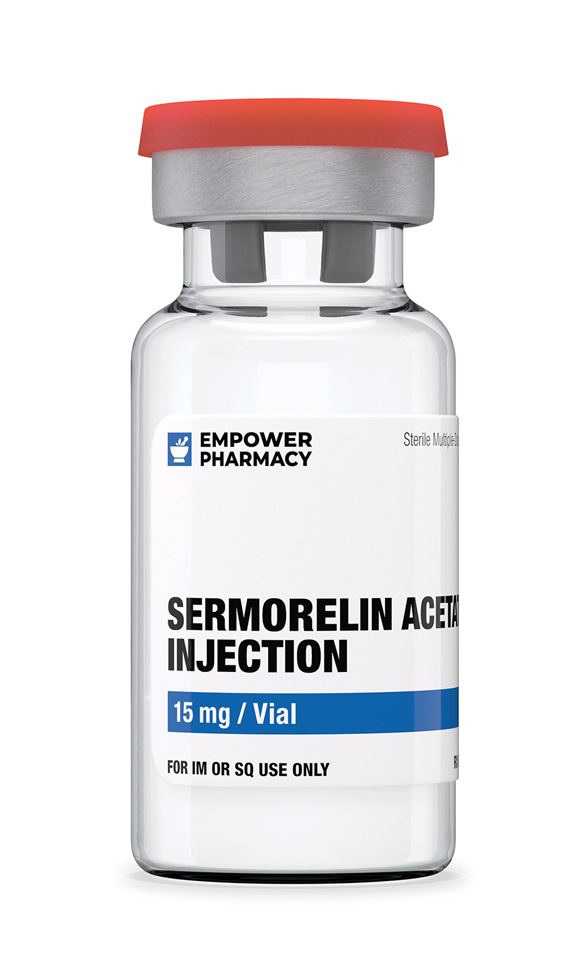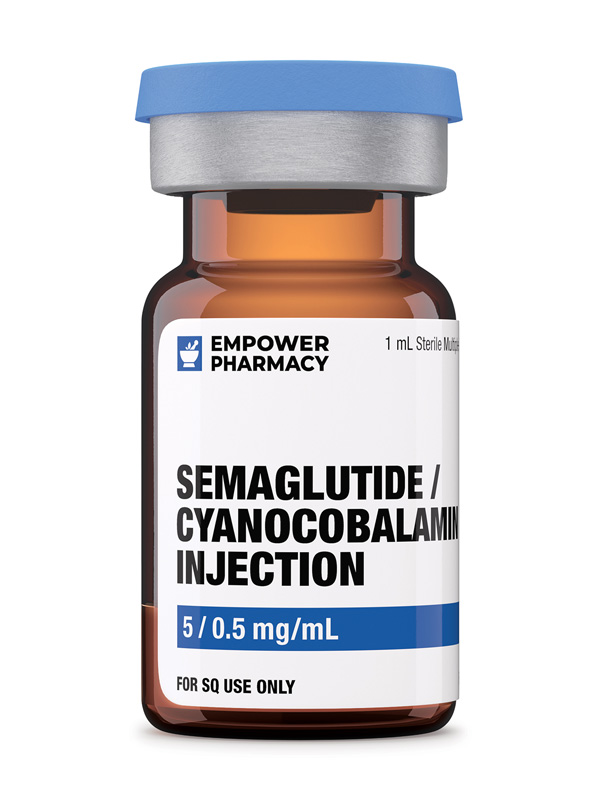Sermorelin Acetate Injection
- Description
- Reviews (0)
- Store Policies
- Inquiries
Description
Dosage Strengths of Sermorelin Acetate Injection
6 mg Lyophilized Vial
9 mg Lyophilized Vial
15 mg Lyophilized Vial
Sermorelin is the structurally truncated analog of Growth Hormone Releasing Hormone (GHRH). It consists of the first 29 amino acids of the naturally occurring neurohormone that is produced in the hypothalamus. Sermorelin is the most widely used member of the GHRH analogue drug class. It can significantly promote the synthesis and release of growth hormone (GH) from cells in the pituitary gland, improving the serum concentrations of GH and subsequently insulin-like growth factor 1 (IGF-1) in animals and humans. It is able to influence the concert of hormonal signals that affect GH secretion from the anterior pituitary including GHRH, somatostatin, and insulin like growth factor (IGF) and others. The positive and negative opposing regulation of growth hormone by GHRH and somatostatin, respectively, creates a rhythmic-circadian pattern of GH secretion. Thus, modification of both pulse amplitude and frequency of GH secretion results from Sermorelin administration. After sermorelin stimulates the release of GH from the pituitary gland, it increases synthesis of IGF-1 in the liver and peripheral tissues.
Sermorelin acts on the growth hormone releasing hormone receptor (GHRHr) in the pituitary to regulate cellular activities. GHRHr is the natural receptor for the endogenous hormone, GHRH, and for sermorelin. This receptor regulates growth hormone release directly by stimulation and indirectly by a feedback relationships with somatostatin.
Sermorelin is readily degraded after reaching the bloodstream, having a biological half-life of approximately 10-20 min. Due to the biological half-life and bioavailability of Sermorelin, administration for growth in childhood GHD must occur periodically several times a day as subcutaneous-injections. However, single daily dosing is sufficient to treat most cases of adult-onset GH insufficiency. Three (3) mcg/kg subcutaneous-injections of Sermorelin have been reported to simulate a naturally occurring GHRH mediated GH release responses.
In addition to increasing production and secretion GHRH also affects sleep patterns by increasing the amount of slow wave sleep (SWS) while augmenting sleep-related GH secretion and reducing cortisol secretion.
To exert all its beneficial effects, Sermorelin requires a functioning pituitary and a host of peripheral tissues. This is due to the reliance on endogenous receptors controlling hormone secreting glands and tissues. More precisely, functioning growth hormone releasing hormone receptors (GHRHr) are required on somatotrophs in a functioning anterior pituitary.
Sermorelin essentially mimics the hypothalamic peptide, GHRH. Sermorelin acts directly on the pituitary stimulating the somatotroph cells ability to produce and secrete GH. Sermorelin increases proliferation of somatotroph cells during development. With the increase of serum GH, downstream effects occur. A notable hormone that is commonly used as a surrogate for growth hormone therapy, insulin like growth factor 1 (IGF-1), is known to increase with the administration of Sermorelin. IGF-I negatively regulates GHRH-mediated GH secretion.
Sermorelin is able to influence the concert of hormonal signaling that effects the GH axis. GH secretion from the anterior pituitary is regulated by GHRH, somatostatin, and GH secretagogues. The positive and negative opposing regulation of growth hormone by GHRH and somatostatin creates a rhythmic-circadian GH secretion. GH asked by signaling target cells, most notably increasing the synthesis of IGF-1 in the liver and peripheral tissues.
Sermorelin acts on the growth GHRHr in the pituitary to regulate cellular actives. GHRHr is the natural receptor for the endogenous hormone GHRH, a signaling hormone produced by the hypothalamus. This receptor among many other functions, controls growth hormone release, mainly by inhibition of somatostatin activity.
Tell your doctor of all prescription and nonprescription medication you may use, especially: corticosteroids and thyroid medications. This drug may affect the results of certain lab tests (e.g., inorganic phosphorus, alkaline phosphatase). Make sure laboratory personnel and your doctors know you use this drug. Do not start or stop any medicine without approval from your healthcare provider. Hypothyroidism: Untreated hypothyroidism can jeopardize the response to Sermorelin. Thyroid hormone determinations should be performed before the initiation and during therapy. Thyroid hormone replacement therapy should be initiated when indicated. Intracranial lesions: Patients with GH deficiency secondary to an intracranial lesion were not studied in clinical trials; Sermorelin treatment is not recommended in such patients. Obesity, hyperglycemia or hyperlipidemia: Subnormal GH responses have been seen in obesity and hyperglycemia, and in patients with elevated plasma fatty acids.
FDA pregnancy risk category C. Laboratory Tests: Serum levels of inorganic phosphorus, alkaline phosphatase, GH and IGF-I may increase with therapeutic use. Corticosteroids: Glucocorticoids may inhibit the response to Sermorelin. Controlled studies did not indicate an interaction of Sermorelin with drugs commonly used in the treatment of routine pediatric problems/illnesses. However, formal drug interaction studies have not been conducted.
Exercise caution during breastfeeding; it is not known if this drug is excreted in breast milk.
Call your doctor for medical advice if pain/swelling/redness occurs at the injection site (occurring in approximately 16% of patients). Other possible, but less common side effects of rhGH (not Sermorelin) are upper respiratory conditions, nerve sensitivity, insomnia, depression, nausea, hypothyroidism chest pain, gynecomastia, headache, flushing, dysphagia, dizziness, hyperactivity, somnolence, urticaria and sore bones. Call your health care provider immediately if you are experiencing trouble swallowing, vomiting, and tightness in the chest. Antibody formation to Sermorelin has been reported after chronic subcutaneous administration of large doses but their clinical significance is unknown. Antibodies do not appear to affect growth hormone release nor appear to be related to a specific adverse drug reaction profile. No generalized allergic reactions have been reported. A temporary allergic reaction described by severe redness, swelling and urticaria at the injection sites has been reported in one patient who developed antibodies. Additionally, its use may reduce insulin sensitivity, thereby raising blood sugar to levels which could be harmful to diabetes sufferers. It may also decrease triiodothyronine (T3) levels due to its tendency to reduce the bodily levels of sodium, potassium, and phosphorous.
Store this medication at 68°F to 77°F (20°C to 25°C) and away from heat, moisture and light. Keep all medicine out of the reach of children. Throw away any unused medicine after the beyond use date. Do not flush unused medications or pour down a sink or drain.
Learn how to prepare medication for self-administered injection.
1.Wehrenberg WB, Ling N. 1983. “In vivo biological potency of rat and human growth hormone-releasing factor and fragments of human growth hormone-releasing factor”. Biochem Biophys Res Commun. 115 (2): 525–530.
2.Chen, R.G., et al., 1993. A comparative study of growth hormone (GH) and GH-releasing hormone (1-29)-NH2 for stimulation of growth in children with GH deficiency. Acta Paediatr Suppl, 388: p. 32-5; discussion 36.
3.Perez-Romero, A., et al., 1999. Effect of long-term GHRH and somatostatin administration on GH release and body weight in prepubertal female rats. J Physiol Biochem, 55(4): p. 315-24.
4.Tannenbaum, G.S. and Ling N. 1984. The interrelationship of growth hormone (GH)-releasing factor and somatostatin in generation of the ultradian rhythm of GH secretion. Endocrinology, 115(5): p. 1952-7.
5.Tauber, M.T., et al., 1993. Growth hormone (GH) profiles in response to continuous subcutaneous infusion of GH-releasing hormone(1-29)-NH2 in children with GH deficiency. Acta Paediatr Suppl, 388: p. 28-30; discussion 31.
6.Howard AD, Feighner SD, Cully DF et al. 1996, A Receptor in Pituitary and Hypothalamus That Functions in GH release. Science. Vol. 273, Issue 5277, pp. 974-977
7.Esposito, P., et al., 2003. PEGylation of growth hormone-releasing hormone (GRF) analogues. Adv Drug Deliv Rev, 55(10): p. 1279-91.
8.Kirk JM, Trainer PJ, Majrowski WH, Murphy J, Savage MO, Besser GM. 1994. Treatment with GHRH(1-29)NH2 in children with idiopathic short stature induces a sustained increase in growth velocity. Clin Endocrinol (Oxf). 41(4):487-93.
9.Aitman, T.J., et al., 1989. Bioactivity of growth hormone releasing hormone (1-29) analogues after SC injection in man. Peptides, 10(1): p. 1-4.
10.Steiger, A., et al., 1994. Growth hormone-releasing hormone (GHRH)-induced effects on sleep EEG and nocturnal secretion of growth hormone, cortisol and ACTH in patients with major depression. J Psychiatr Res, 28(3): p. 225-38.
11.Mayo, K.E., et al., 1995. Growth hormone-releasing hormone: synthesis and signaling. Recent Prog Horm Res, 50: p. 35-73.
12.Ceda, G.P., et al. 1987. The growth hormone (GH)-releasing hormone (GHRH)-GH-somatomedin axis: evidence for rapid inhibition of GHRH-elicited GH release by insulin-like growth factors I and II. Endocrinology, 120(4): p. 1658-62.
13.Mayo, K.E., et al., Growth hormone-releasing hormone: synthesis and signaling. Recent Prog Horm Res, 1995. 50: p. 35-73.
14.Ceda, G.P., et al., The growth hormone (GH)-releasing hormone (GHRH)-GH-somatomedin axis: evidence for rapid inhibition of GHRH-elicited GH release by insulin-like growth factors I and II. Endocrinology, 1987. 120(4): p. 1658-62.
15.Tannenbaum, G.S. and N. Ling, The interrelationship of growth hormone (GH)-releasing factor and somatostatin in generation of the ultradian rhythm of GH secretion. Endocrinology, 1984. 115(5): p.
Be the first to review “Sermorelin Acetate Injection”
General Inquiries
There are no inquiries yet.










Reviews
There are no reviews yet.